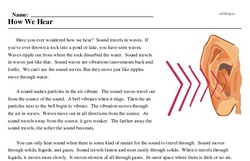How We Hear
Have you ever wondered how we hear? Sound travels in waves. If you've ever thrown a rock into a pond or lake, you have seen waves. Waves ripple out from where the rock disturbed the water. Sound travels in waves just like that. Sound waves are vibrations (movements back and forth). We can't see the sound waves. But they move just like ripples move through water.
A sound makes particles in the air vibrate. The sound waves travel out from the source of the sound. A bell vibrates when it rings. Then the air particles next to the bell begin to vibrate. The vibration moves through the air in waves. Waves move out in all directions from the source. As sound travels away from the source, it gets weaker. The farther away the sound travels, the softer the sound becomes.
You can only hear sound when there is some kind of matter for the sound to travel through. Sound moves through solids, liquids, and gases. Sound travels fastest and most easily through solids. When it travels through liquids, it moves more slowly. It moves slowest of all through gases. In outer space where there is little or no air, sound waves cannot travel. Sounds cannot be heard in outer space. Sound waves must have a medium to travel through. The medium can be a solid like the ground. It can be a liquid like water. Or it can be a gas like air.
Imagine trying to catch a small ball. You might cup your hands together. Shaping your hands that way helps you catch the ball. Our ears are shaped like cups to help catch sound waves from the air. Our ears have three main parts.




